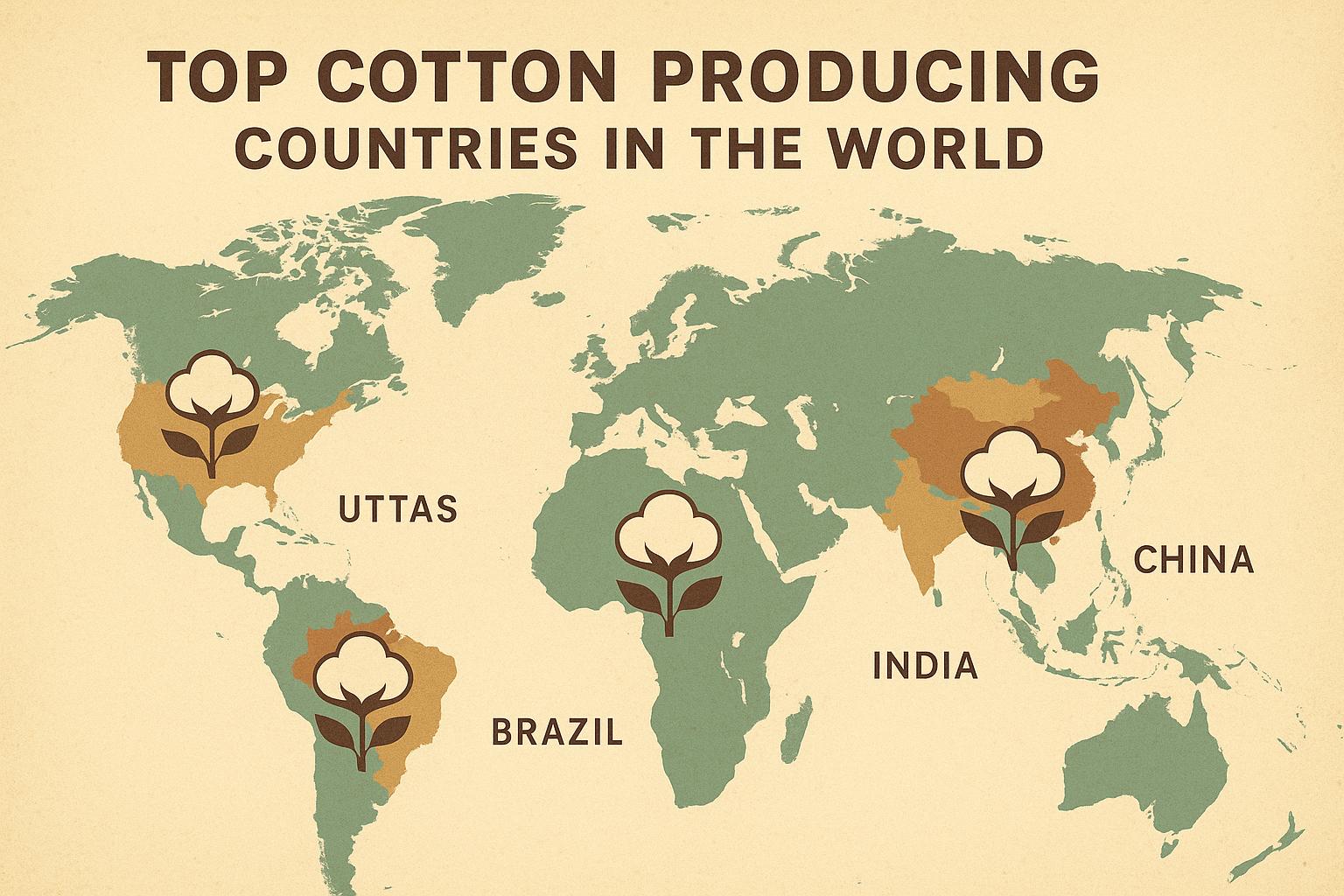Cotton farming is evolving to address resource depletion and environmental concerns. By adopting smarter techniques, farmers are reducing water use, cutting chemical dependency, and improving soil health - all while maintaining or increasing yields. Here’s a quick overview of the five most effective methods transforming cotton farming today:
- Water-Saving Irrigation: Advanced systems like drip irrigation reduce water waste by up to 80% and boost efficiency by 75%.
- Organic Pest Control: Integrated Pest Management (IPM) cuts pesticide use by 47%, using natural predators and precision tools.
- Crop Rotation: Alternating crops improves soil fertility, reduces fertilizer use by 30%, and increases yields by 20%.
- Improved Soil Techniques: No-till farming and composting enhance soil quality, store up to 450 kg of carbon per hectare, and reduce erosion by 60%.
- Integrated Farm Systems: Combining practices like precision farming and conservation tillage increases income by 11% while reducing waste.
These practices show that sustainable farming can balance productivity with reduced environmental impact. Let’s dive deeper into each approach.
Water and Soil Management in Cotton Production
1. Using Water-Saving Irrigation Methods
Over the last 20 years, modern irrigation technology has drastically improved water use in cotton farming. Farmers have achieved a 75% boost in water efficiency, with irrigation water usage dropping by nearly 80% per hectare.
Advanced Irrigation Systems
Drip irrigation and precision sprinklers are game-changers. These systems focus water delivery directly to plant roots, cutting down on waste. To fine-tune water use, farmers rely on tools like:
- Soil moisture probes
- Infrared sensors to track water needs
- Computer models to perfect irrigation schedules
Real-World Implementation
In Pakistan, more than 75,000 farmers participating in the Better Cotton Initiative cut their water usage by 39% using advanced irrigation methods. This shows that farms of all sizes can benefit from smart water management.
Advantages of Water-Saving Systems
Switching to efficient irrigation systems brings a range of benefits:
| Benefit Category | Impact |
|---|---|
| Resource Efficiency | Up to 80% less water used, plus lower energy bills |
| Crop Health | Better yields due to precise water delivery |
| Environmental | Less water pollution and reduced runoff |
| Operational | Lower labor costs for managing irrigation |
Flexible Options for Every Farm
Water-saving irrigation methods work for farms of any size. Smaller farms might start with simple drip systems, while larger ones can adopt advanced precision tools. Farmers can pick solutions that match their budget, crop needs, and local conditions. These practices not only save water but also support eco-friendly and cost-conscious farming.
Efficient irrigation is just one part of the equation - effective pest control is another key to sustainable cotton farming.
2. Controlling Pests with Organic Methods
Integrated Pest Management (IPM) has helped cotton farmers cut chemical pesticide use in half since the 1980s. This approach has transformed pest control by focusing on organic methods that reduce chemical dependency and encourage a healthier farming environment.
Natural Pest Management Solutions
Farmers are turning to nature for pest control. By planting cover crops and maintaining a mix of vegetation, they create habitats that attract helpful insects like ladybugs and lacewings. These insects handle pests such as whiteflies and bollworms without the need for chemicals.
Balancing Costs and Benefits
Although organic pest control often involves higher initial costs, it pays off in the long run. It lowers pesticide expenses, improves soil health, and reduces water pollution-related costs, proving to be a smart investment over time.
Smarter Pest Monitoring with Technology
Modern tools like drones, data analytics, and precision agriculture allow for early pest detection and targeted action. These technologies make organic pest control more precise and efficient.
Real-World Results
The Better Cotton Initiative has shown impressive results, cutting pesticide use by 47% and chemical fertilizer use by 39% across 300,000 hectares. This shift has improved soil health and increased biodiversity.
Positive Environmental Effects
Organic pest control reduces chemical runoff, which helps protect water sources and preserves vital pollinators. These methods contribute to a healthier ecosystem, supporting sustainable cotton farming practices.
While pest control is key to healthier crops, integrating crop rotation can further enhance soil quality and reduce disease risks, strengthening the overall farming system.
3. Rotating Crops for Better Soil and Yields
Switching up the crops grown on a piece of land doesn’t just protect the soil - it also boosts long-term farming success, both economically and environmentally.
Choosing the Right Crops
In Pakistan, over 75,000 farmers have improved their practices through carefully planned crop rotations. This approach has cut water use by 39% while keeping yields strong. The secret? Picking crops that naturally boost soil fertility, creating a win-win for both the land and the farmer.
Financial Benefits of Rotation
Cotton farmers who rotate their crops are seeing real financial rewards. Studies show yields can grow by up to 20% when cotton is alternated with other crops that complement it. Plus, these farmers are using about 30% less synthetic fertilizer, saving money and reducing environmental impact.
Smart Rotation Combinations
Modern farming relies on pairing crops strategically. For example, legumes like soybeans add nitrogen to the soil, while cereals like rye help improve its structure.
| Benefit | Impact |
|---|---|
| Increased Yields | Up to 20% |
| Less Fertilizer Use | Up to 30% |
| Reduced Soil Erosion | Up to 50% |
| Lower Pesticide Use | Up to 50% |
Starting Small on Small Farms
For smaller farms, even a simple two-crop rotation can make a difference. Programs like those offered by WWF help farmers create plans tailored to their land and market needs, making it easier to get started.
Using Technology to Improve Rotations
Precision tools are helping farmers monitor soil health throughout the rotation process. Adding cover crops during the off-season adds another layer of protection, further improving soil quality.
Crop rotation doesn’t just improve soil health - it also reduces the need for chemical inputs, setting the stage for even more sustainable farming practices in the future.
sbb-itb-0e617ca
4. Improving Soil Health with New Techniques
No-Till Farming and Cover Crops
Combining no-till farming with cover crops is a game-changer for cotton production. This method keeps soil structure intact, cuts down on erosion, and significantly boosts soil carbon levels. For instance, no-till practices alone can store up to 450 kilograms of carbon per hectare annually. They also improve water retention by 30% and reduce erosion by as much as 60%. Adding cover crops to the mix further enriches organic matter, creating a healthier and more resilient growing environment.
Compost and Smarter Soil Management
Using compost effectively can lower fertilizer use by 15–30%, saving money while improving soil quality. U.S. cotton farmers have shown just how impactful better soil management can be, achieving an 82% improvement in irrigation efficiency between 1980 and 2015 [1]. This enhanced ability to retain water helps farms withstand drought conditions and lowers costs tied to water usage.
Leveraging Technology for Soil Health
New soil monitoring tools allow farmers to track progress in real-time. Precision equipment ensures compost and nutrients are applied exactly where they’re needed, cutting down on waste and improving results. These tools make sustainable practices more accessible and practical for farms of all sizes, supporting both environmental goals and financial stability.
Real-World Impact
Healthier soil strengthens the effectiveness of water-saving and pest-control strategies. Small-scale farmers, in particular, gain from these methods, as they require little upfront investment but offer lasting savings. The combination of no-till farming, cover crops, and targeted nutrient application provides a strong foundation for sustainable cotton farming.
5. Managing Farms with Integrated Systems
Unified Approach to Farm Management
Integrated farm management brings together various sustainable farming practices into a single, cohesive system. It focuses on coordinating efforts like water conservation, pest management, soil care, and crop rotation to improve both efficiency and overall outcomes.
Using Technology to Streamline Farming
Advanced tools now allow farmers to monitor and manage their operations in real-time. With precision technology, decisions about irrigation, fertilization, and pest control are guided by data, ensuring resources are allocated effectively across the farm.
Boosting Profits and Reducing Waste
Farmers using integrated systems have seen an 11% increase in income, thanks to lower input costs and higher yields. By harmonizing different sustainable methods, these systems help reduce waste while improving profitability and resource use.
Positive Effects on the Climate
Integrated systems play a key role in cutting emissions and addressing climate change. When paired with conservation tillage, they not only store more carbon but also enhance farm productivity, making them a win-win for farmers and the environment.
Support Systems for Adoption
Programs like the Regenerative Cotton Fund provide farmers with training, infrastructure, and financial assistance. These resources make it easier for farmers to transition to integrated systems and maintain sustainable practices over the long term.
Adapting to Different Farming Contexts
These systems have shown they can work across various farming environments and scales. By blending traditional farming knowledge with modern tools, they offer a practical way to implement sustainable practices worldwide.
Conclusion
Cotton farming has seen a major shift with the introduction of sustainable methods, offering benefits for both the environment and agricultural productivity. The Better Cotton Initiative's work in Pakistan is a prime example of this progress: farmers there have reduced water usage by 39%, cut pesticide use by 47%, and boosted their income by 11%. These results show how sustainable farming can tackle environmental issues while improving livelihoods.
Globally, sustainable cotton farming is proving that eco-friendly practices and profitability can go hand in hand. Techniques like precision farming and modern irrigation systems are delivering clear benefits to both farmers and the ecosystems they rely on. For example, conservation tillage captures 450 kg of carbon per hectare each year, contributing to climate goals while enhancing soil health and farm output.
Switching to sustainable practices does come with challenges, such as upfront costs and the need for training. However, the long-term rewards - like using fewer resources, healthier soil, and better financial returns - make the effort worthwhile. Programs like the Regenerative Cotton Fund play a key role by offering training, infrastructure, and financial support to help farmers make the transition.
The path forward for cotton farming is clear. Water-saving irrigation, organic pest management, crop rotation, and improved soil techniques are paving the way for a more resilient and environmentally friendly industry. Now is the time to adopt these approaches and ensure a sustainable future for cotton farming around the world.
FAQs
What is the best method of irrigation for cotton?
Drip irrigation, especially subsurface systems, delivers water straight to the roots, reducing evaporation and improving lint quality. Research shows it can increase cotton yields by 10-30% while using 15-30% less water compared to surface irrigation.
How can organic pest control methods help in cotton farming?
Organic pest control supports a balanced farming system by introducing helpful insects and using biopesticides. Detecting pests early and applying targeted solutions helps keep crops healthy while safeguarding the surrounding ecosystem.
What are the advantages of crop rotation in cotton farming?
Rotating cotton with nitrogen-fixing crops like legumes enriches soil fertility and keeps pests in check. This method makes crops stronger and reduces the need for chemical inputs.
How can soil health be improved in cotton farming?
To improve soil health, farmers can:
- Add compost and manure
- Use cover crops
- Practice intercropping
These techniques increase organic matter in the soil, improve water retention, and reduce erosion.
What are integrated systems in cotton farming?
Integrated systems bring together methods like precision farming, efficient water use, and organic pest control into one cohesive strategy. This approach increases profitability while cutting resource use, showing how farming can balance productivity with environmental care.
These approaches not only tackle challenges in cotton farming but also support long-term productivity and environmental well-being.


